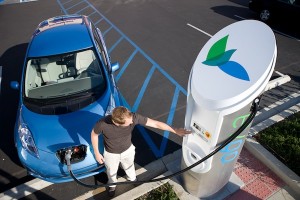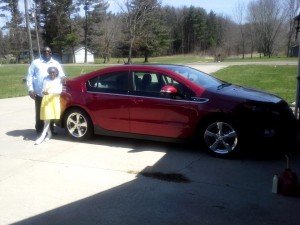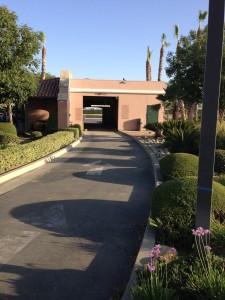The falling prices at the pump have been welcome news for drivers and consumers. It’s hard not to feel like gas prices are the ultimate determinant of our economic well-being. When they go up, the economy stalls, such as in the 1970s, early 2000s, and then the recent economic malaise following the Great Recession. And when they go down, the economy seems to hum, like in the 1990s and now with our increasingly robust economic recovery. Cheap energy underpins virtually everything we do, and transportation fuels are the key inputs for our industrial machine.
We know this industrial production and activity comes at an environmental cost. But is there reason to believe this time is different? There’s no doubt cheap gas means more pollution, at least in the short run. It’s encouraging less efficient vehicle purchases (SUV sales are up although electric vehicle sales so far are holding steady), more driving, and more economic activity that tends to produce more carbon emissions.
 But there are environmental positives, some immediate and some more potential. In the immediate future, cheap oil means environmentally destructive oil and gas extraction methods, such as fracking, become too expensive to continue relative to the cheap global price of oil. The decrease in investment in these methods could have long-term consequences on supply, once this oil boom fades. And since these extraction methods often produce both oil and natural gas, the slowdown could drive up natural gas prices as a byproduct. That in turn could make renewables more cost-competitive and possibly discourage wasteful gas consumption, spurring efficiency overall.
But there are environmental positives, some immediate and some more potential. In the immediate future, cheap oil means environmentally destructive oil and gas extraction methods, such as fracking, become too expensive to continue relative to the cheap global price of oil. The decrease in investment in these methods could have long-term consequences on supply, once this oil boom fades. And since these extraction methods often produce both oil and natural gas, the slowdown could drive up natural gas prices as a byproduct. That in turn could make renewables more cost-competitive and possibly discourage wasteful gas consumption, spurring efficiency overall.
The other long-term potential environmental good is that a booming economy is a big factor in making voters more likely to support environmental measures (the so-called “affluence hypothesis”). So as many people experience rising income or more disposable cash from cheaper energy, environmental leaders should take the opportunity to solidify environmental policies. In California, that would mean legislating 2030 and maybe even 2050 greenhouse gas reduction goals to extend AB 32 (the state’s climate law) authority beyond 2020. That could also mean switching from the gas tax to a vehicle miles traveled tax to develop a more stable source of funding to repair existing roads and pay for new transit, pedestrian and bike infrastructure. Legislators could develop a permanent funding source to help build more affordable housing near transit. And it could also mean reforming Proposition 13 to allow local governments to raise voter-approved revenue for transit with a 55% majority.
At the national level, a booming economy could undermine efforts to rollback EPA regulations to reduce pollution from power plants, while correspondingly lead to more support for a nationwide vehicle miles traveled tax to fund transportation. (I’d love a national policy on carbon, too, but I don’t think that even a booming economy could overcome the structural impediments that disproportionately empower rural, fossil-fuel dependent states in the federal decision-making process.) And maybe a booming economy could make it easier for the Obama Administration to negotiate a more meaningful international climate treaty in Paris next year.
So the potential upsides of cheap gas are huge, while the known immediate downsides may be unavoidable. Let’s hope our environmental leaders capitalize on this opportunity while they have it. Because if history teaches us anything, it’s that cheap gas never lasts.
It’s official — the site in California’s Central Valley, along Interstate 5 at Harris Ranch, is Tesla’s first battery swap station. As I speculated earlier this month, Tesla unveiled the station last week in a blog post:
Starting next week, we will pilot a pack swap program with invited Model S owners. They will be given the opportunity to swap their car’s battery at a custom-built facility located across the street from the Tesla Superchargers at Harris Ranch, CA. This pilot program is intended to test technology and assess demand.
At least initially, battery swap will be available by appointment and will cost slightly less than a full tank of gasoline for a premium sedan. More time is needed to remove the titanium and hardened aluminum ballistic plates that now shield the battery pack, so the swap process takes approximately three minutes.
With further automation and refinements on the vehicle side, we are confident that the swap time could be reduced to less than one minute, even with shields. Tesla will evaluate relative demand from customers for paid pack swap versus free charging to assess whether it merits the engineering resources and investment necessary for that upgrade.
If the pilot program is successful, and ownership models for the batteries can be determined, Tesla may have just begun a major innovation in electric vehicle driving. The program could herald two major breakthroughs: first, it solves “range anxiety” by allowing drivers to travel long distances without having to endure lengthy and uncertain battery charging sessions at public chargers. Second, it could potentially decrease the price of the vehicles dramatically by removing the cost of the battery from the purchase price.
How so? Well, I’m not sure Tesla (and other automakers) would be interested in this second benefit, but they could arrange car purchases where the automaker retains ownership of the battery and leases it to the customers when they purchase the vehicle. Then when the battery swap happens, a customer is simply swapping one leased battery for another, with a performance guarantee from the automaker on the lease. The automaker would benefit by ultimately reselling the used batteries for grid storage and other market opportunities (and increasing vehicle sales). The customer benefits by not having to pay for the full cost of the battery (a huge part of the purchase price) and by not shouldering the uncertainty of long-term battery performance.
And to imagine even more possibilities, when you couple the battery lease option with the possible revenue from vehicle-to-grid services performed by plugged in vehicles via grid signals, you have a recipe for a very inexpensive vehicle, an essentially free battery lease, and a better performing grid to boot.
Nissan LEAF is currently number one in electric vehicle sales, the result of CEO Carlos Ghosn’s vision to build a low-cost EV to create a mass market. Ghosn sat down recently with Charlie Rose to discuss the current state of EVs, worth watching in full:
On a related note, with the LEAF now finally entering the realm of profitability on the heels of 200,000 units sold worldwide, Nissan is launching a major new ad campaign. Charged EV magazine has the details. Here’s a sample ad from the “Kick Gas” campaign:
Blogging will be light as I’m in Paris for an “electromobility” conference at the ESSEC Business School. I’ll be presenting on Friday on the case study of electric vehicle deployment in Hawaii, the subject of a report I co-authored last year called Electric Vehicle Paradise: How Hawaii Can Lead The World In Deployment. Au revoir! (That’s sadly the extent of my French language skills.)
 In case you’re in the market for a super-expensive, environmentally beneficial vehicle, Teslarati does a convenient side-by-side comparison of the Model S with the Toyota Mirai. The cars actually come out pretty even, with one glaring exception: the ease of fueling.
In case you’re in the market for a super-expensive, environmentally beneficial vehicle, Teslarati does a convenient side-by-side comparison of the Model S with the Toyota Mirai. The cars actually come out pretty even, with one glaring exception: the ease of fueling.
In our view, one of the major benefits of BEVs [battery electric vehicles] is that you refuel them at home, overnight, while you’re sleeping, so that your Model S is “full” every morning. Unless you travel long distances on a regular basis, you will rarely need a Tesla Supercharger or any other refueling source away from home. That’s huge, and often get’s lost in the discussion of “range anxiety” that always seems to invade the thinking of those who don’t own a Model S. Although fuel cells are sexy, it seems odd to us that Toyota has returned to a 20th century fueling station paradigm. In essence, there is little difference between refueling a Mirai and refueling a Camry. Sure, the fuel is different, but you have to hunt for a specific refueling station as your Mirai slowly depletes its hydrogen. No charging at home—ever.
Not to mention that the hydrogen can be energy-intensive to generate and may not come from clean sources. As I’ve written before, there are big question marks about the long-term environmental benefits of investing in hydrogen fueling. It may be necessary for some big cargo trucks that can’t otherwise be powered efficiently by batteries, but we shouldn’t look to it as a panacea for passenger vehicles.
Either way, we’ll need the prices on both vehicles to come down significantly in order to make a dent in our transportation emissions.
And the honor goes to Erik Belmer of Ohio:
Erick Belmer is the proud owner of a 2012 Volt.
As Belmer tells InsideEVs, the Volt was purchased on March 28, 2012. Since then, it’s seen a daily commute of 220 miles there and back, with a single longest trip of 430 miles in a day.
Oil changes come every 38,000 miles and tire rotations every 10,000 miles. That’s basically all the maintenance that’s been required on Belmer’s Volt.
The particularly good news is that Belmer has seen no loss in battery capacity after all that driving:
“Volt is holding up flawlessly! No noticeable battery capacity loss. Used 9.7 kw because it’s a 2012. I am so pleased with this vehicle!”
“The Volt was always my dream car! To get to drive it everyday is a dream come true! This car is Wonderfully engineered!”
One important note is that the Chevy Volt has a gas engine that kicks in after about 40 miles of electric driving. So we won’t see this kind of mileage accrue in such a short period of time in an all-battery electric like the Nissan LEAF or BMW i3, which don’t have the range of the Volt on a daily basis.
But if all-battery EVs have their batteries hold up like Belmer’s, that bodes very well for the long-term value of the car. It would be reassuring to customers, many of whom are opting to lease the vehicles, in part out of doubts about long-term battery life. It also bodes well for the quality of second-life batteries, which can be reused outside of the vehicle for different energy storage options.
It’s an unsubstantiated rumor, but the Harris Ranch Tesla Supercharger site in the Central Valley (off I-5 between San Francisco and Los Angeles) may be getting the first one in the “modern” era. Here’s an eyewitness account:
While charging at Harris Ranch on the way back from the shareholder meeting I was chatting with the employees at Subway inside the Shell gas station market, I was told by someone (not a Subway employee) who works there that Tesla is putting in the battery swap station where the car wash is currently located, I guess the car wash is broken & they don’t want to get it fixed so they struck a deal with Tesla & plans have been drawn up to build the station where the car wash is currently, best guess is should be open in about 6 months or so & will be manned with Tesla personal for awhile until they get the kinks worked out, several times Elon has mentioned the first station will be on the I-5 & this area is perfect.
We know that Tesla batteries can be swapped faster than it takes to get gas. If you could “refill” your Tesla battery for another 250 miles or so in just a minute or two by swapping in a fresh one, it would solve the range anxiety/charging time issue completely.
There are really no technical barriers to pulling this off, but in practice it can be complicated. The battery is the most expensive part of the vehicle (tens of thousands of dollars in a car like the Tesla). So if you just drop the battery off for a new one every time you’re out and about, who is going to own it? And how are you going to know the quality of the new battery you’re receiving? And how will it affect the purchase price of the vehicle?
The EV charging company “Better Place” introduced this battery swapping business charging model a few years back, but the company got crushed. Bottom line is that the automakers didn’t want to give up possession of the battery ownership for a swapping model.
But given Tesla’s ambitions to be an energy storage company as much as a car company, it may make sense for them to retain ownership of the batteries. It solves the range and potentially the cost issues of the cars, and it also gives Tesla an opportunity to flip the batteries for energy storage whenever they need to.
If the Harris Ranch swap station is happening, it’s likely a pilot project for the company to evaluate. But it could portend a new era in how electric vehicles are engineered, operated, sold, and — most importantly — experienced by drivers.
New information on Tesla’s Nevada gigafactory indicates that the company is making a major play for the stationary storage market (i.e. backup battery systems for homes and businesses and maybe stacked batteries for bulk energy storage. According to CEO Elon Musk:
“Stationary storage is a vital element for going to sustainable power generation and we are currently assuming that somewhere around 30 percent or so of the Gigafactory output would be aimed at stationary storage, that’s a rough guess, says Musk. But, one way or another, stationary storage is going to be a really huge thing that needs to be done.”
30 percent is a pretty staggering figure for a company making such great headway on the vehicle side. Of course, we need both types of energy storage, for transportation and for decarbonizing the grid. Meanwhile, plans for the factory are coming along, with some production possibly beginning as soon as 2016.
I hope they hurry up — I’ll be in line to get their mass-market Model 3 as soon as it’s available.
A satire waiting to happen:
A Tesla driver reports on his epic (11,000-mile) all-electric US road trip this summer. The driver went from his home in Seattle to national parks in California and then out to Maine. His only real challenge was the “Great Montana Supercharger Desert” between Rapid City, South Dakota and Ritzville, Washington — a distance of 916 miles with only a single Supercharger in Billings, Montana.
 First of all, it’s great to know that such a road trip is possible, although at this point it’s only for the most economically successful among us who can afford a Tesla. Second, this is the result of Tesla’s investment in a nationwide supercharger network, so they should be congratulated on providing this level of service for their customers. And finally, it’s a nice window into the future road trip possibilities for electric drives, once the costs come down and the infrastructure improves in the coming decade.
First of all, it’s great to know that such a road trip is possible, although at this point it’s only for the most economically successful among us who can afford a Tesla. Second, this is the result of Tesla’s investment in a nationwide supercharger network, so they should be congratulated on providing this level of service for their customers. And finally, it’s a nice window into the future road trip possibilities for electric drives, once the costs come down and the infrastructure improves in the coming decade.
But more importantly, this driver offers a common sense list of requirements for a functioning public charger network, and it’s a list that could apply even to Level 2 chargers for less expensive electric vehicles (I recommend reading the whole thing). I hope policy makers and charging companies alike take notice. The obvious prime factor is:
Reliability. There is no way around this one; it is key – the charger has to work when you get there. In fact, unreliable chargers are WORSE than no chargers – without chargers, the owner will have made other plans for the trip; but with an unreliable charger, they may encounter a long unexpected delay.
As an EV driver, I don’t really have “range anxiety” about running out of juice on a big drive, but I do have this kind of “charger anxiety.” Will the charger I expect to use be functional when I arrive? And relatedly, will it be available or will there be a long line?
The driver makes another important point about what he calls “usability.” No key fobs, please, or complicated charging company networks that you have to sign up for in order to use the charging equipment. We need to make the transaction as smooth as possible, just like a gas station credit card reader.
Once we solve these seemingly minor but significant hurdles, more of us will be in a position to take the kind of all-electric road trip that this driver got to enjoy.




